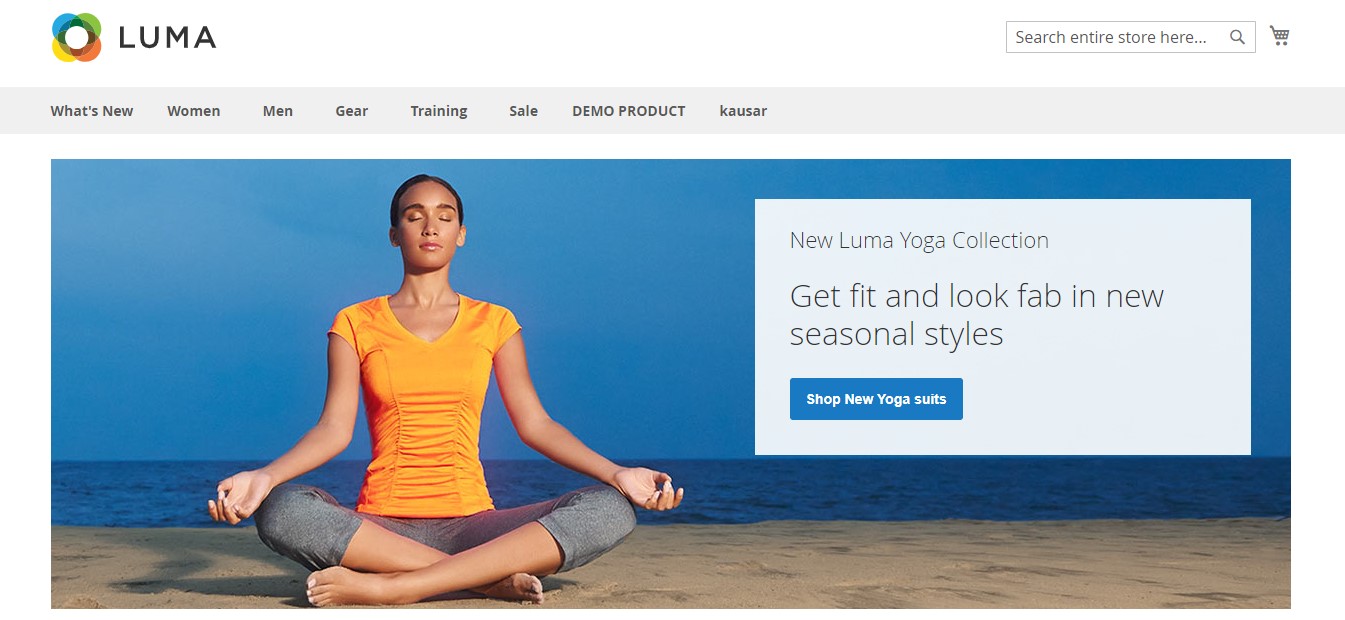User experience (UX) is one of the strongest weapons that can support Magento websites in achieving their revenues and reputation goals in the e-commerce industry race. To win this competitive battle now is the right time for you to start investing in your own Magento website’s UX and outweigh other rival companies.
If you have no idea of how to reinforce this essential factor and are looking for some practical tips to improve it, you have come to the right place. This article is written just for you and your business!
Let’s look at these specific guides on how to create better user experiences for your Magento website.
1. Improve Page Load Speed
In the fast-paced world of online shopping, where users have little patience for sluggish websites, optimizing the page load speed of your Magento website is critical. Users are more likely to exit a website if they have to wait longer than a few seconds.
Therefore, it’s important to address this issue properly. One of the primary culprits behind slow Magento page load speed is the size of website components such as images, scripts, and stylesheets. Large files take longer to download, especially on slower internet connections, leading to a frustrating user experience.
Excessive page redirects and plugins can also significantly impact your Magento store’s load speed. Each redirect or plugin adds an extra layer of processing and can lead to delays in rendering the page.
In our article about Magento performance optimization, we dive deep into these issues, so make sure to give it a read.
2. Create Smooth Navigation
Navigating a Magento website should be as effortless as strolling through a well-organized store. A seamless and intuitive navigation experience is the cornerstone of a good user experience, and it plays a pivotal role in helping visitors find the products they seek.
The navigation bar is your user’s compass within your website. To make it effective, keep navigation links clear, concise, and directly related to the content or categories they represent.

Avoid cluttering the menu with unnecessary items that can overwhelm visitors. Organize links hierarchically, with primary categories on the main menu, and make subcategories and specific items easily accessible through dropdown menus or submenus.
Intuition is key when it comes to categories and subcategories. Base your product classification on your ideal customers’ preferences and shopping habits. Understand how they search for products and align your categories accordingly.
Remember, what constitutes good website navigation can vary depending on your target audience and their shopping behaviors. Conduct user testing and gather feedback to refine your navigation structure continually. A/B testing can also help you determine the most effective navigation layout for your specific audience.
3. Invest In The Mobile Version Of The Website
In today’s digital age, where over 4 billion people worldwide use smartphones, optimizing the user experience for mobile devices is crucial for Magento store owners. To truly enhance user experience, it’s crucial to invest in the mobile version of your Magento website.
Responsive design lies at the heart of the mobile-first strategy. A responsive website adapts and adjusts its layout based on the visitor’s screen resolution.
This means that whether a customer is using a large desktop monitor or a small smartphone screen, they can comfortably navigate your Magento store without encountering usability issues.
Ensuring your Magento website is responsive guarantees that users have a consistent and enjoyable experience, irrespective of the device they use. It eliminates the frustration of pinching and zooming to view content, which often drives potential customers away.
4. Fix 404 Pages

404 errors on your Magento website can disrupt the user experience. It’s crucial to keep your site free of these errors to ensure a smooth and trustworthy online journey for your visitors.
Search engines like Google also take note of 404 errors, and an abundance of them can harm your SEO rankings, reducing organic traffic.
For important links that are no longer valid but still receive traffic or have backlinks, create proper 301 redirects. This ensures users are redirected to the relevant pages seamlessly.
5. Optimize Search Box And Filtering
Imagine a website like Amazon without a search bar—finding specific products would be a challenge. Similarly, on your Magento website, customers searching for specific items might get frustrated if they can’t locate them easily.
The search box is a classic tool that helps customers quickly find products on your website. However, to make the search experience even better, consider adding enhanced filtering features to the search box. These filters, which can include options like colors, price ranges, sizes, and brands, enable users to browse your product catalog more efficiently.
Efficient search and filtering options directly contribute to higher conversion rates. When customers can easily locate their desired items, they are more likely to complete a purchase. By optimizing your search box and filtering tools, you not only enhance user satisfaction but also increase the chances of successful conversions and customer retention.
6. Include Informative Product Descriptions
A well-crafted product description is the gateway to informed purchase decisions for your users. It equips them with the essential knowledge and understanding they need before clicking that “Buy” button.

Informative product descriptions are like a knowledgeable salesperson guiding customers through an online store. They offer insights, specifications, and key details about a product, enabling customers to make informed choices.
Rather than leaving product descriptions blank or using generic content, consider crafting unique descriptions for each item. This demonstrates professionalism and trustworthiness. Customers appreciate the effort taken to provide them with distinct and relevant information.
Crafting the perfect product description is an art. It shouldn’t be overly lengthy or too brief. Instead, aim for a balanced approach. Ensure that your description answers potential questions users might have about the product while avoiding overwhelming them with unnecessary details.
7. Integrate Button Links To Social Media
In today’s digital world, website visitors often want to stay updated with businesses and brands on social platforms like Instagram, Facebook, or Twitter. These platforms provide quick access to the latest news and updates.
By placing social media links on your website, you make it easy for users to connect with your brand’s social profiles. This enables them to follow and engage with your content on their preferred platforms, helping you build a stronger online presence and community.
Integrating social media links creates an image of transparency and accessibility. When users can easily access your social profiles, it shows that you’re open, available, and eager to interact with your audience.
8. Consider Using PWA
Progressive Web Apps (PWAs) represent a fusion of traditional websites and native apps, offering the best of both worlds. They have the potential to significantly enhance the user experience for Magento stores in multiple ways.
PWA is inherently designed with mobile users in mind. It prioritizes mobile usage and provides a tailored design version specifically for smartphones and tablets. This mobile-first approach ensures that users feel at ease while navigating and exploring your Magento store on their mobile devices.

Magento PWA stores provide users with an app-like experience, all without requiring any downloads. These app-mimicking features include home screen icons, splash pages, push notifications, and more. Users can add the Magento PWA icon to their home screen, taking up minimal storage space compared to traditional native apps.
Moreover, Magento PWAs can function even in areas with weak or no network connectivity, thanks to their offline mode. Users no longer need to worry about losing access to your store due to a spotty internet connection, enabling uninterrupted browsing of product categories.
We have a comprehensive article about Magento PWA If you’re interested and want to learn more about it.
9. Align Brand with User Experience
Your brand should seamlessly integrate with the user experience of your website. It should reinforce your messaging, values, and identity throughout the customer journey. This alignment ensures that every interaction on your site resonates with your brand and builds a consistent narrative.
Your brand encompasses various elements, including your logo, fonts, color palette, graphics, and even the language you use. These elements are typically detailed in your brand style guide. Your designer should utilize this guide to visually differentiate your website from competitors.
Consistency is key. A strong, consistent brand presence fosters trust and recognition among your audience. When customers encounter your brand elements consistently on your site, they are more likely to remember your products and return for future purchases.
10. Optimize The Checkout Process
The checkout process is where visitors become customers, but it can be a stumbling block if it’s too complex. To enhance user experience, consider putting all checkout forms on a single page. This eliminates the need for customers to navigate through multiple steps, making the process more straightforward and efficient.
Streamline your checkout forms by removing needless fields. Only request essential information from customers. This reduces friction during the checkout process, as customers aren’t overwhelmed with unnecessary details.

Offer a variety of payment methods to cater to different customer preferences. This flexibility ensures that customers can choose the payment method that suits them best, enhancing their overall shopping experience.
The speed of the checkout process is also critical. Aim to make it as fast as possible to minimize the risk of cart abandonment. A swift and seamless experience encourages customers to complete their purchase without second thoughts.
11. Constantly Testing and Improving
It’s crucial to understand that the pursuit of an exceptional user experience is an ongoing journey.
Small changes can yield significant results. Even a seemingly minor 1% improvement in conversions can translate into a substantial increase in return on investment (ROI). Continuous improvement is about making these incremental gains over time.
Data is your ally in the pursuit of better UX. Utilize analytics tools to gain insights into user behavior, identify pain points, and discover areas for enhancement. Pair quantitative data with qualitative user feedback to gain a holistic understanding of your website’s performance.
The notion that your website is “perfect” is often an illusion. There is always room for improvement, no matter how polished your site may seem. Embrace a mindset of perpetual enhancement.

